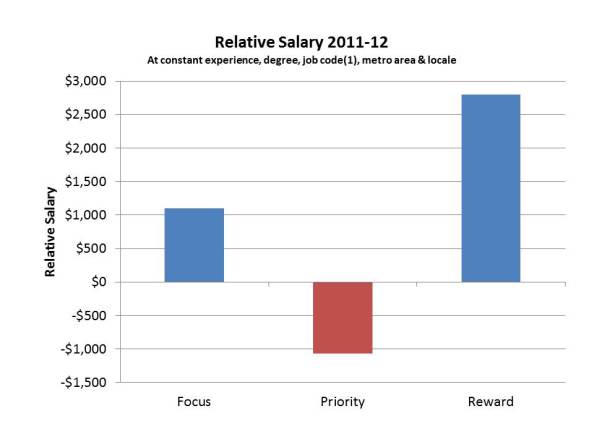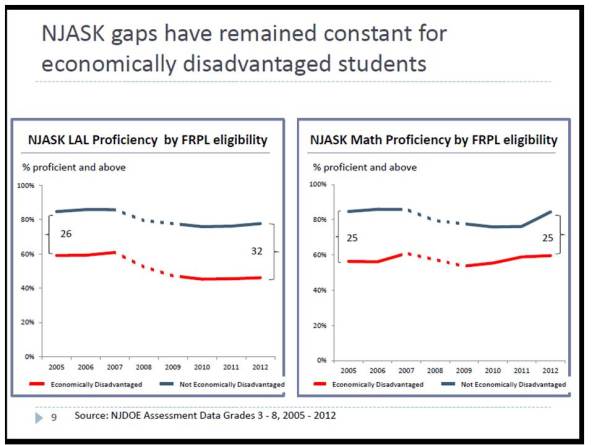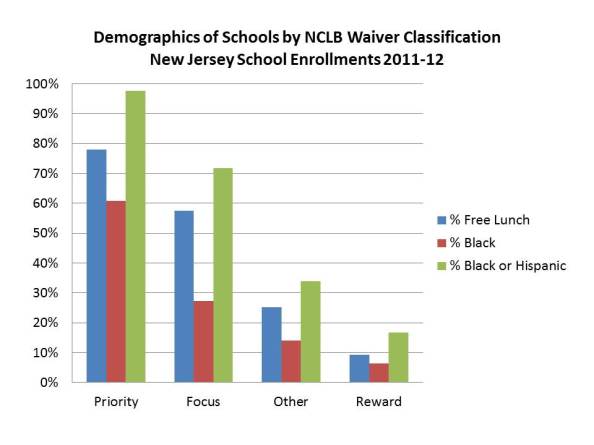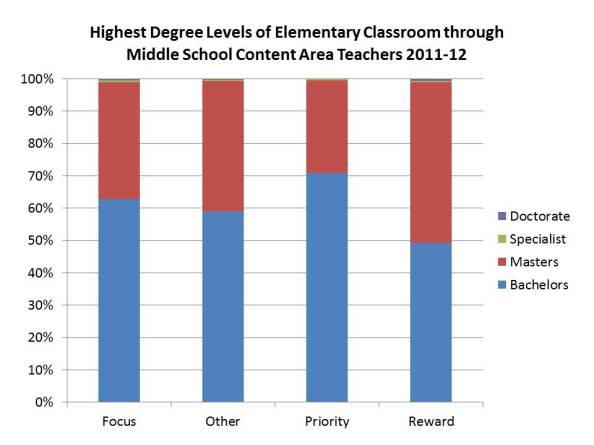Data, Data, Data? Dissecting & Debunking NJDOE’s State of the Schools Message
Time again for an NJ State of the Schools Address, as reported HERE in NJ Spotlight (with absolutely no critical question/reporting whatsoever! More or less spoon fed regurgitation).
As I’ve written a number of times on this blog, state officials in New Jersey have decided on specific marketing/messaging plan in order to support current policy initiatives. Those policy initiatives involve:
- expanding NJDOE authority to impose desired “reforms” (charter/management takeover, staff replacement, etc.) on specific schools otherwise not under their direct authority.
- cutting funding from higher poverty, higher need districts and shifting it toward lower poverty, lower need ones.
- expanding charter schooling and promoting other “innovations” in high poverty concentration schools.
The supposed impetus for these reforms is that New Jersey faces a very large achievement gap between low income and non-low income children (one that is largely mis-measured). While it would seem inconsistent to suggest reducing funding in low income districts and shifting it to others, the creative messaging has been that the additional resources are quite possibly the source of the harm… or at the very least those resources are doing no good. Thus, the path to improvement for low income kids is to transfer their resources to others. What I have found most disturbing about this messaging – other than the ridiculous message itself! – is the flimsy logic and disingenuous presentations of DATA that have been used to advance the argument.
Look if the message is going to be about Data, Data, Data – then now is the time to take a more thorough, context-sensitive look at the data, and try to better understand what’s really going on.
Let’s do a walk through of some of the information presented in the most recent state of the schools presentation.
Here’s a link to the slides from the recent presentation:
http://www.state.nj.us/education/news/2012/0919con.pdf
NJDOE Message
The most recent state of the schools presentation is now in the post-NCLB waiver era, where we are now presented with those template classifications of schools as Priority, Focus and Reward schools.
The state of the schools presentation revolves to a large extent around these categories, because it is those Priority schools that are the target of the most immediate and disruptive interventions.
Below are the slides that were presented to characterize schools by their performance category. The message to be conveyed by these slides was:
- Priority Schools are overspenders (or at least very well resourced)
- Priority Schools have very well paid teachers who have slightly higher than average experience
- Yet still, priority schools have really crummy outcomes!
Therefore, we must have wide latitude to intervene!
EXHIBIT A – PRIORITY SCHOOLS SPEND MORE(?)
EXHIBIT B – PRIORITY SCHOOLS HAVE HIGH PAID TEACHERS & LOW OUTCOMES!
EXHIBIT C- GAPS REMAIN LARGE
Omitted Information What about demographic differences?
Clearly, a few things are being overlooked in the first two slides which claim characterize Priority schools as schools with plenty of resources that simply don’t get the job done. Now, there’s a little more to the story than that!
Most notable, as I show below, priority schools have about 80% of children qualified for free lunch and reward schools less than 10%! Yet as the NJDOE slide above shows, at the high end these school districts spend slightly under 30% more than state average. Notably, this shoddy comparison does not compare these districts to others in their own labor market.
Indeed, New Jersey more than other states has put some money into these districts. See “Is school funding fair?” But, let’s be clear, these margins of funding difference, while helpful, hardly make these districts – given their needs – flush with excess resources!
In fact, the strongest empirical research on this topic suggests that it would take an additional 100% or so per pupil funding for a district that is 100% low income versus a district that is 0% low income. Here, we are looking at nearly that extreme of low income differential, and not nearly that extreme of funding support! So while these districts are better off than similar districts in other states, implying that they’ve got more than enough to close achievement gaps is a huge stretch.
But do those demographic differences matter?
This figure shows just how much the demographic differences represented above matter with respect to student achievement, and specifically how much school demography continues to dictate the performance classification of schools under the NJDOE waiver plan.
As I pointed out on a recent post, NJDOE has basically flagged schools in low income neighborhoods for experimentation and substantial disruption (closure, etc.) with an option to override any/all local input.
Notably, this pattern is likely better than it would otherwise be because of New Jersey’s past efforts to target additional resources to high need settings, including pre-kindergarten programs, smaller class sizes and more competitive teacher salaries than might otherwise exist in these settings.
What about the teacher pay and teacher characteristics claim?
But what about those salaries? The NJDOE slides present a picture of teachers who – by their argument – are certainly paid enough. And, in fact, setting aside (ignoring entirely the demography of the schools), the implication of the NJDOE slides is that hey… we’re paying these teachers a few thousand more than the average teacher in the state, but clearly they just aren’t very good, or at least there are a bunch of them that aren’t and need to be fired! Further, they have slightly more experience than teachers in other schools… yet they still stink… indicating that experience clearly doesn’t matter. Notice that they didn’t present degree levels.
Okay… now let’s do a legitimate walkthrough of the most recent available data on NJ teachers with respect to the performance categories of schools. I use the 2011-12 Fall Staffing Reports and I fit a regression model of teacher salaries for all elementary and middle level classroom teachers (secondary later if I get a chance). In that model, my goal is to compare the salary a teacher would make:
- at the same experience level
- with the same degree level
- having the same job code
- working full time
- in the same labor market (and type of district in that market)
- in the same year
That is, I’m comparing apples with apples. This first graph shows the average difference in salary on the above comparison bases, statewide. Statewide, teachers in priority schools are earning a lower salary and teachers in reward schools a higher salary than teachers in “all other schools.” But these averages do mask some important differences across labor markets.
 Here are the North Jersey/NY projected teacher salaries by experience level, where Newark carries significant weight in the model. Priority school salaries by experience are in blue, reward in red. On average, the differences are rather subtle. Reward schools salaries jump ahead in the mid-range, and priority rise again later, but fall behind in the mid range. But, it’s really important to understand, that simply having roughly the same salary does not mean that salary is actually competitive for recruiting and retaining teachers of comparable qualifications! In fact, to get teachers to work in a high need setting is likely to require a substantively higher wage!
Here are the North Jersey/NY projected teacher salaries by experience level, where Newark carries significant weight in the model. Priority school salaries by experience are in blue, reward in red. On average, the differences are rather subtle. Reward schools salaries jump ahead in the mid-range, and priority rise again later, but fall behind in the mid range. But, it’s really important to understand, that simply having roughly the same salary does not mean that salary is actually competitive for recruiting and retaining teachers of comparable qualifications! In fact, to get teachers to work in a high need setting is likely to require a substantively higher wage!
As I explain in a recent review of the literature on this topic: With regard to teacher quality and school racial composition, Hanushek, Kain, and Rivkin (2004) note: “A school with 10 percent more black students would require about 10 percent higher salaries in order to neutralize the increased probability of leaving.”33 Others,however, point to the limited capacity of salary differentials to counteract attrition by compensating for working conditions.34 see:http://www.shankerinstitute.org/images/doesmoneymatter_final.pdf
- Hanushek, Kain, Rivkin, “Why Public Schools Lose Teachers,” Journal of Human Resources 39 (2) p. 350
- Clotfelter, C., Ladd, H.F., Vigdor, J. (2011) Teacher Mobility, School Segregation and Pay Based Policies to Level the Playing Field. Education Finance and Policy , Vol.6, No.3, Pages 399–438
- Clotfelter, Charles T., Elizabeth Glennie, Helen F. Ladd, and Jacob L. Vigdor. 2008. Would higher salaries keep teachers in high-poverty schools? Evidence from a policy intervention in North Carolina. Journal of Public Economics 92: 1352–70.
Now let’s look at south jersey, which appears to be the source of most of the deficit that shows up statewide. In South Jersey/Philly metro, teachers in priority schools are making a much lower wage especially in the mid-range. Non-classified and reward schools lead the way on salaries across most of the experience range. Hey… is this chicken or egg? Do salaries matter – or are more advantaged schools simply able to pay higher salaries.
One issue that NJDOE appears to be ignoring entirely is that the classification of these schools may actually lead to additional teacher sorting – making it even harder to staff priority schools with high quality teachers down the line.
Here are the degree levels of classroom teachers in these schools – something notably absent in the NJDOE presentation. The differences between priority and reward schools are quite striking.
PRIORITY SCHOOLS HAVE FAR MORE TEACHERS WITH ONLY A BA AND FEWER WITH AN MA THAN REWARD SCHOOLS!
Finally, here are the concentrations of novice teachers, where a sizable body of research literature points to the problem of teacher churn in high need schools and the relationship between high novice teacher concentrations and lower student outcomes.
What about the performance of low income children in New Jersey?
Again, part of the message being presented in the state of the schools address is that New Jersey in particular has failed its low income children – as indicated by the suspect, over time proficiency rate graphs presented above. These graphs are presented as coupled with the funding/resource graphs to imply that funding is clearly unhelpful at best and harmful at worst when it comes to fixing the achievement gap.
As I’ve written on this blog before, New Jersey has made substantive gains in recent decades for low income children. Further, to make comparisons of achievement gaps, one must focus on the most comparable measures and most comparable settings. In one recent blog post, I compared Massachusetts, Connecticut and New Jersey – which in terms of income distributions and the characteristics of those above and below the Free/Reduced Income thresholds are most similar. The following graphs show that children of HS dropouts and low income children in NJ and MA have both higher levels of performance and have outpaced the gains in performance of similar children in Connecticut and Rhode Island (but especially CT!)
What has New Jersey done to improve performance of low income children?
I also elaborated in that previous that one key difference between these states is that NJ and MA, more than the others have shifted resources toward higher need districts. The first graph shows the disruption over time in the relationship between district income and district resources. MA and NJ have most significantly disrupted this relationship, providing systematically more resources per pupil in lower income districts.
This second graph shows the pattern across districts by poverty in each state. Note that in CT, while a few high poverty districts (Hartford and New Haven) have higher current spending, the CT pattern is less systematic. Further, in those few districts, much of the additional spending is granted through magnet school aid, and thus may have limited positive impact on the districts’ neediest students.
To the best of my understanding, teacher tenure laws are/were strong in each of these states. Few if any districts in these states base teacher evaluation heavily on student test scores – especially during the periods represented in the graphs above – which predate Race to the Top. That is, clearly the differences in low income achievement growth between these states have little/nothing to do with state teacher evaluation policy. To go even further, NJ and CT have relatively small charter school market share, so charter school market share likely is not a major factor either.
Further, as explained in this report, and in this article, substantive and sustained school finance reforms do matter! And the evidence on the effectiveness of these reforms far outweighs the more speculative reforms being suggested as replacements for funding in New Jersey.
What does NJDOE & the current administration propose to do about future funding?
Finally, as I noted previously, the current direction of policy initiatives is to attempt to reshuffle funding away from higher poverty/need districts and toward lower poverty/need ones. Here’s the graph from the previous post.
The Strange Logic of it All?
Coupling this DOOHNIBOR (uh… reverse robinhood) strategy with arguments for disruptive reforms in high poverty settings is illogical at best and reckless and irresponsible at worst.
Children in high poverty settings in New Jersey have made substantive gains over time.
It is quite likely that New Jersey’s investments in the schools and communities of these children have played a significant role in those gains.
Yet, even in New Jersey, where the state has made those efforts, poverty-related disparities do persist and require attention.
There is little or no evidence that expanded charter schooling is substantively improving the outcomes of our lowest income children, largely because those “successful charter schools” of which we most often speak are not serving our lowest income children in any significant numbers, and in some cases areincreasing concentrations of disadvantaged children left behind in district schools.
And there’s little evidence that either New Jersey’s failures or gains are a function of an oversimplified good teacher/bad teacher dichotomy, suggesting a need for oversimplified reformy solutions like teacher deselection and/or pay-for-test scores.
Despite the state’s efforts to provide support to high poverty settings/schools, teacher wages still are not where they necessarily need to be in those districts to recruit and retain a high quality applicant pool year after year. There remain disparities in teacher qualifications, including novice teacher concentrations. Teacher quality disparities may be/are an issue – but not in the way they are presently being framed!
These are the basic issues that need to be addressed. They aren’t sexy. They aren’t reformy. They aren’t consistent with the current marketing/messaging of NJDOE.
But they are based on data, data, data, DATA, DATA and more freakin’ Data!
And there’s a lot more where that came from!
This blog post has been shared by permission from the author.
Readers wishing to comment on the content are encouraged to do so via the link to the original post.
Find the original post here:
The views expressed by the blogger are not necessarily those of NEPC.















